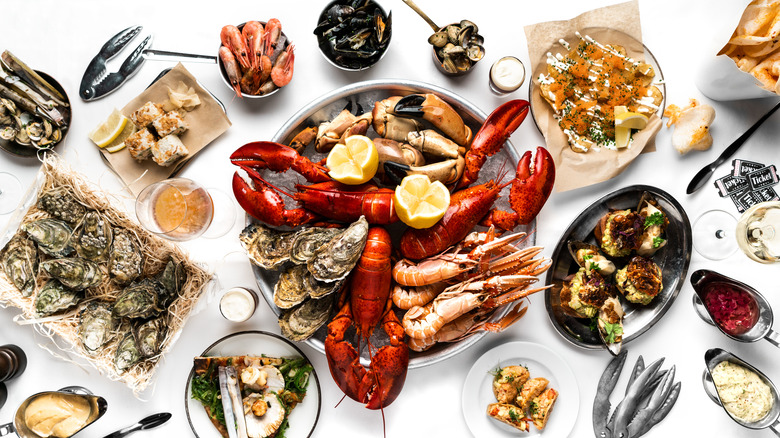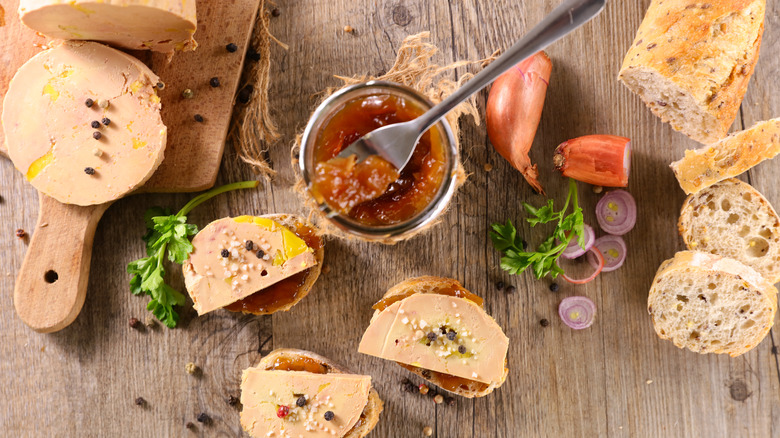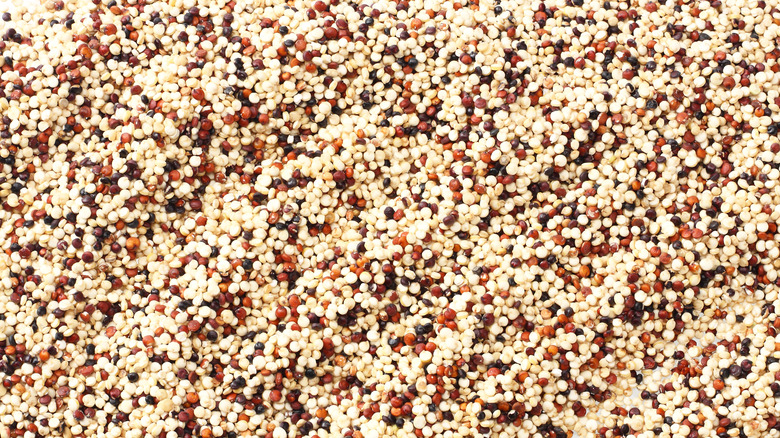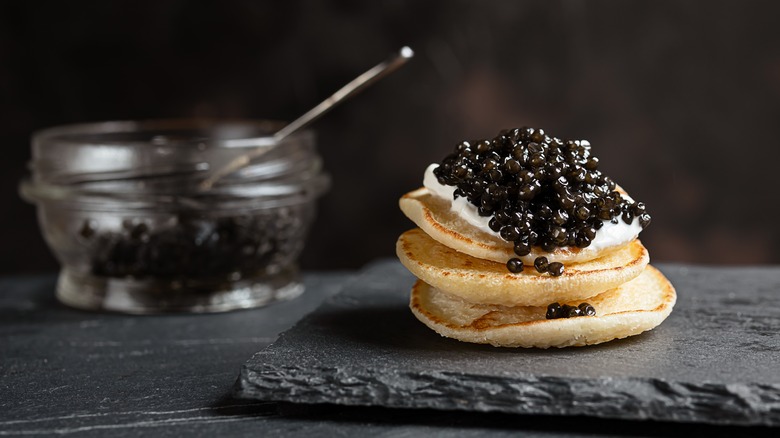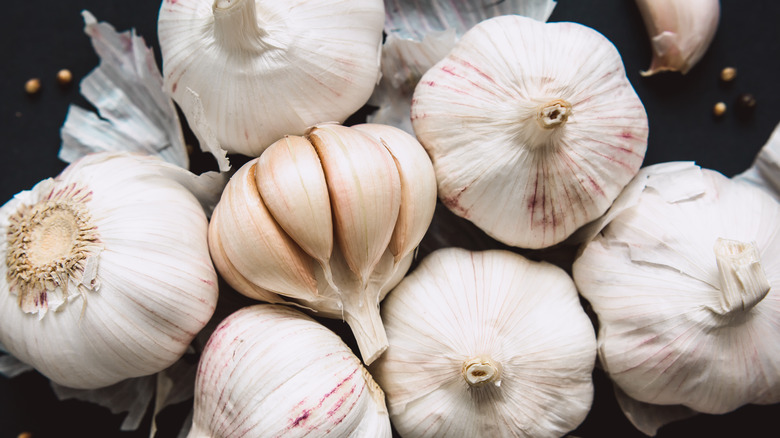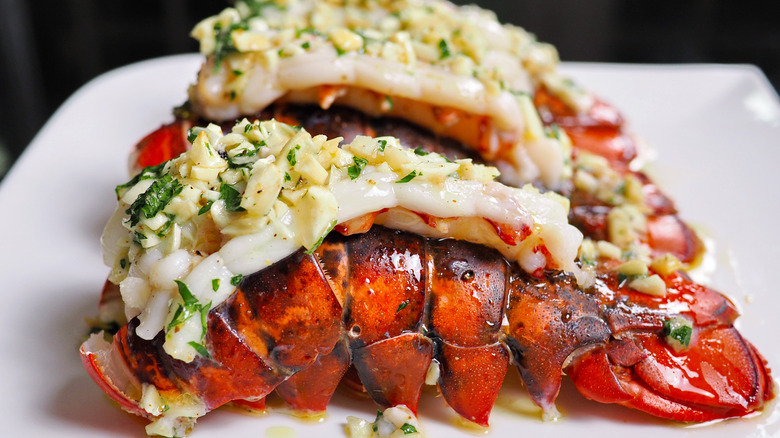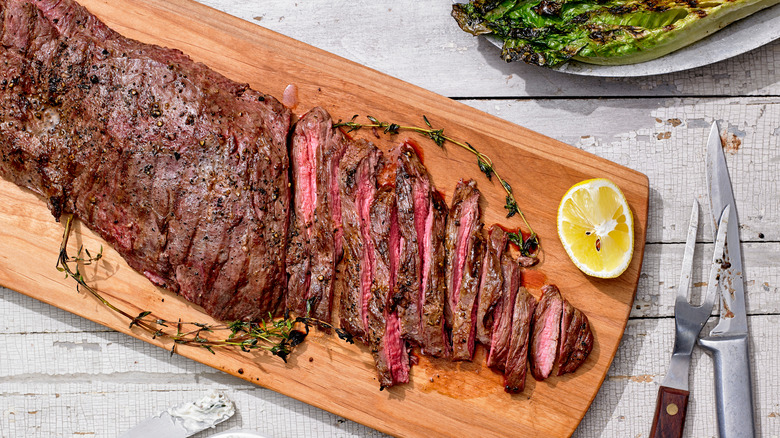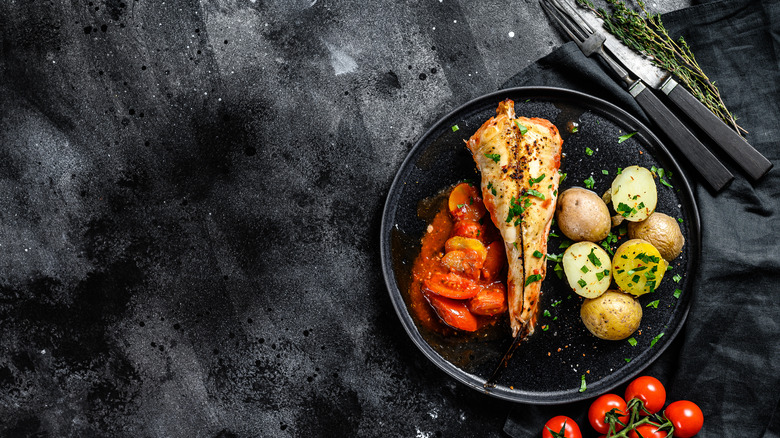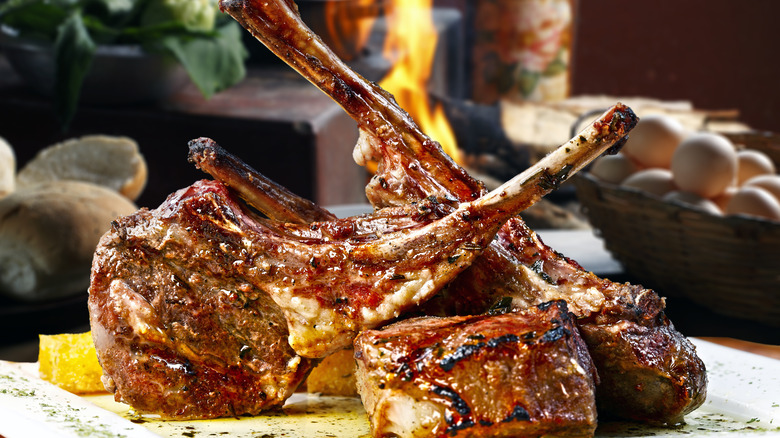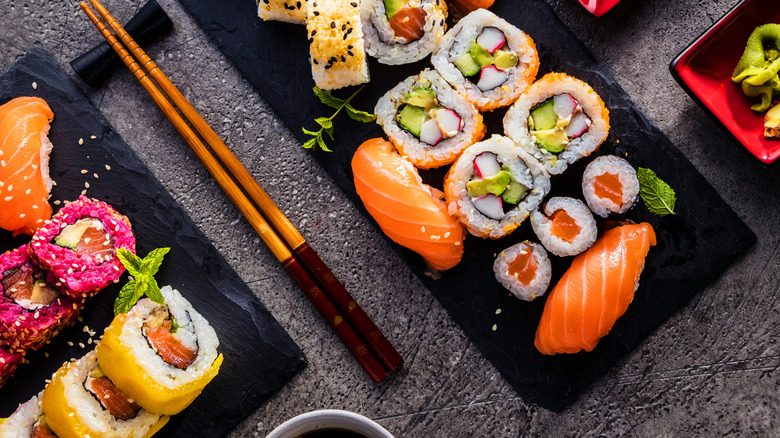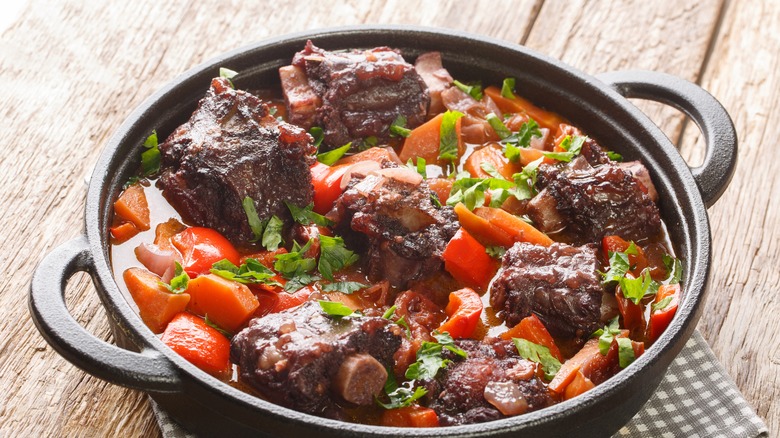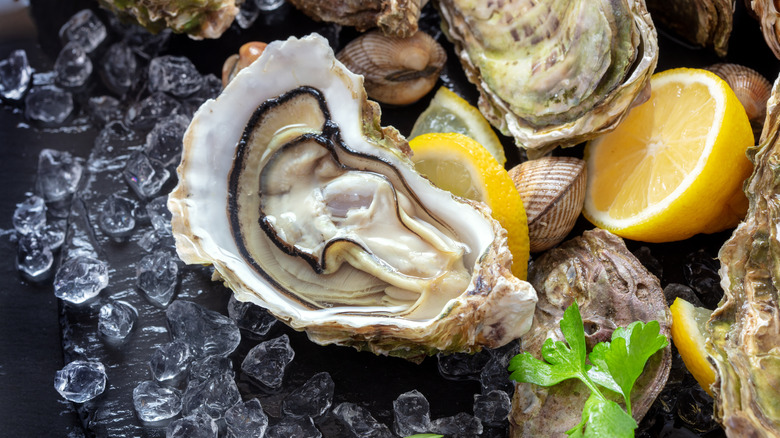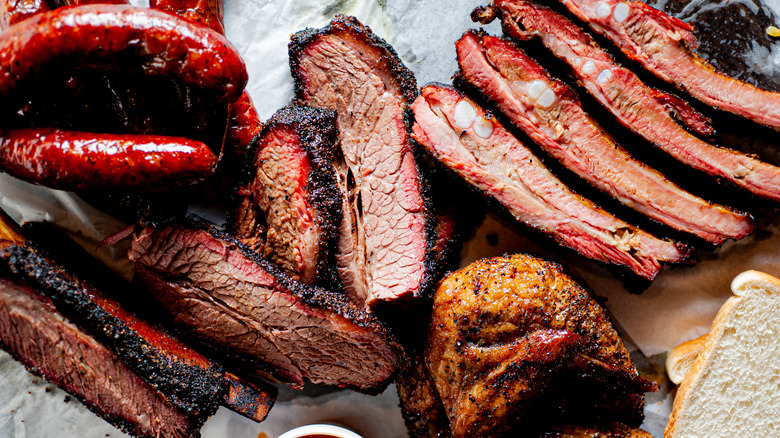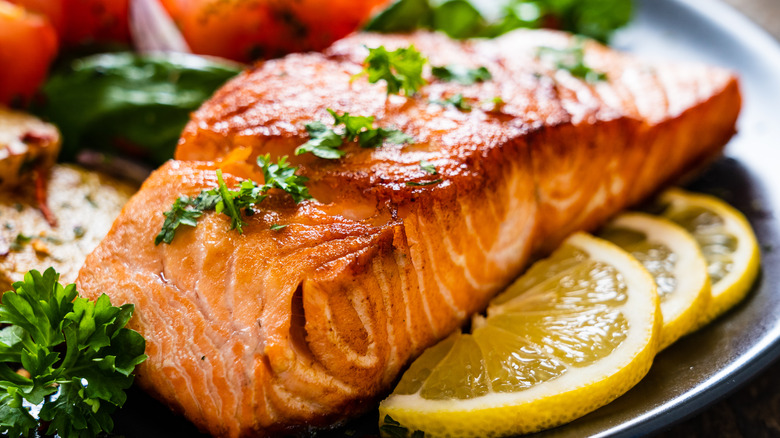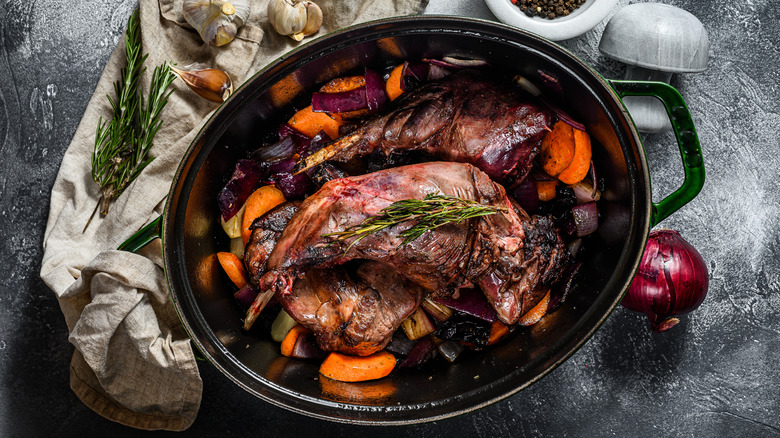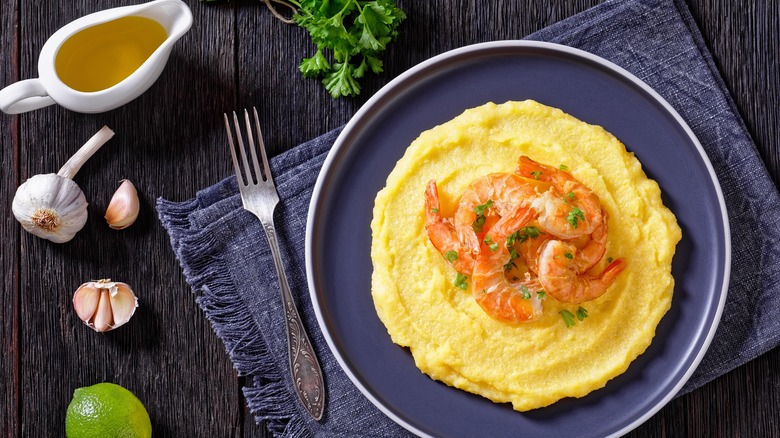Expensive Foods That Were Once Cheap
If you hit up a trendy steakhouse or a Michelin star restaurant, there are certain expensive food items you might expect to see on the menu. There's often good reason for the price of things, from availability to the amount of labor that goes into getting certain items on your plate. Additionally, the reputation of certain foods can also drive up their price. However, not all of the favorite foods of the rich and famous have always only been ultra spendy.
Foods go in and out of style all of the time. The 1950s were full of gelatin-based monstrosities that you can't (and luckily won't) find on most restaurant menus today. Even in the 2010s, we were dealing with food trends, as it was hard to find a brunch spot that didn't have some rendition of avocado toast on their menu. Oftentimes when things get popular, they get more expensive. For some menu items, it's been taken to the extreme.
We decided to find a few expensive food items that were once considered cheap and easily accessible for the everyday person. It's a shame that, these days, it isn't as economical to chow down on oysters and lamb chops at every meal as it was in decades past.
Foie gras
Foie gras, pâté made from the fatty livers of geese or ducks, is a delicacy and a controversial dish that traces back centuries. These days, according to Moment Magazine, a pound of fresh foie gras can cost $90 and that's before it even hits the customer's plate.
It's peculiar, as liver tends to be some of the cheapest protein you can buy. However, foie gras is far from your average liver. Ducks and geese are more expensive to raise than chickens, taking longer to mature. Additionally, the livers are enlarged through the controversial process of force feeding, which adds to supply and labor costs. Additionally, some countries have banned the force feeding process altogether, meaning that there are only a small amount of farms that handle the complex production of all foie gras (via Insider).
Before foie gras was synonymous with fancy French cooking, Egyptians discovered the rich taste fatty duck livers. After that, Jewish people needed a substitute for butter, and poultry fat was a cheap option. They kept the practice of fattening the birds alive and immigrants ultimately brought the technique to the U.S. Once it went more mainstream in high-end French restaurants, the price reflected that demand (via WSJ).
Quinoa
One health food that saw a massive boom in the late 2000s and early 2010s was quinoa, a tiny grain (though technically it's a seed, as per Harvard) with a massive protein punch that has been a staple food in South America for centuries. Once the grain became popular in U.S. and Europe, prices rose along with its profile (via Farm & Animals).
Between 2000 and 2014, the price of a pound of quinoa rose from $0.25 to $4, a 1,500% increase due to increasing demand (via Borgen Project). The growing process for quinoa can be long and costly, as it takes 90-120 days to produce, which is likewise reflected in the price (via ItsFoodtastic). Considering the majority of quinoa is cultivated in South America, transportation costs also factor into the price.
Ultimately, the quinoa fad resulted in increased income for the Andean farmers cultivating the product (via NPR). Yet the Borgen Project reports that, since its peak, the price of Bolivian quinoa dropped to $0.60 per pound in 2018. But considering its steady popularity, high protein content, and the fact that it is gluten free, the price of the grain will likely never decrease too drastically on the customers' end.
Caviar
Even if you have no idea what caviar is, you probably know it's a well-known expensive food. It's a food synonymous with wealth and abundance, even though it tends to come in extremely small packages. However, the high price tag tends to be a result of increased demand, lower supply, and the allure of the product.
In certain eras, there was such an abundance of sturgeon that it was seen as food for the poor. Particularly, people preferred the meat of the fish to the eggs, and would pair caviar with a cheap and filling dish like porridge (via Forbes). In the 19th century, the U.S. had so much sturgeon that caviar was served in saloons for free like peanuts in sports bars today. The salty fish eggs encouraged patrons to purchase more alcohol (via The Spruce Eats).
The current high price of caviar reflects the unsustainable fishing methods that make it harder to harvest. Additionally, female sturgeons take around eight years to produce eggs, meaning it takes plenty of time and labor to produce caviar. If you pair that with the high demand of the luxury good, there's no chance any bar would be doling out tins for free.
Garlic
Garlic is one of those staple ingredients that most people have on hand at all times. In the U.S., about 80% of garlic comes from China, as the bulb is native to central Asia (via WSJ). It's been used for its taste and medicinal qualities for centuries, from the Greeks to the Egyptians to the Japanese. Outside of its culinary uses, some people in medieval Europe used to carry bulbs around to ward off vampires (via CNN).
However, since the COVID-19 pandemic, the price of garlic has been on the rise. The pandemic disrupted the global supply chain in general, and more people were cooking at home more often in 2020. Therefore, the demand for garlic was high, but border shutdowns and other issues made it difficult to import (via WSJ). In 2021, domestic garlic farmers also dealt with high temperatures, droughts, and other environmental factors that blunted their harvests.
What's more, exports from China hit a 6-year low in February 2022 (via Fresh Plaza). The trickle-down effects of the pandemic are still impacting the market, which still results in temporary price increases. Luckily, considering garlic is an abundant crop, the record-high prices should likely go down.
Lobster
If you are looking to order the fanciest item on the menu, you can't go wrong with lobster. It's one of the most decadent seafood items ever — right? While a massive lobster roll or grilled tail will cost you a pretty penny these days, it used to be almost too easy to eat on a regular basis.
Lobster has been a staple New England dish since its presence on the first Thanksgiving table. However, it wasn't as highly regarded as it is today, considering it reportedly washed up on the beach in two-foot-high piles. In fact, during the 19th century, a can of Boston baked beans was four times more expensive than a can of lobster meat. It's important to note that lobster was cooked dead in that era, rather than alive, which made the meat less tasty. Lobster meat was even fed to cats during that time (via Pacific Standard).
As cooking methods improved, lobster became a delicacy in the 20th century. Since then, it's been a game of supply and demand with lobster prices. Lobster farms don't exist, so supply is solely reliant on lobstermen's annual harvests. Additionally, the animals can take several years to grow to market size, meaning that the price of lobster can vary widely from one year to another (via Seafood Source).
Skirt steak
If you think of an expensive steak, cuts like filet mignon and New York strip might come to mind. However, skirt steak, taken from the diaphragm of the cow below its ribs, has gone from an affordable cut to one of the pricer options at the butcher counter. In a 1989 New York Times article, skirt steak was listed as the second most expensive cut of beef for wholesale buyers after tenderloin. In fact, the cut increased the value of a cow by $6 a head at the time. The reason? In the '80s, it was the rising popularity of fajitas at Tex-Mex restaurants. No one can resist a sizzling steak skillet.
More recently, as pointed out in 2015 by Epicurious, skirt steak went from cheap to totally expensive. A pound can cost you at least $20 these days — peculiar for a thin steak that's far tougher than tenderloin. Since the onset of the COVID-19 pandemic, the price for all meat has been high due to supply chain, labor issues, and other rising costs (via Price of Meat). Secondly, more people have come to realize that skirt steak is a simple and reliable cut to have on hand at all times. It's easy to prepare and versatile, making it more popular than it was when it would only set you back just a few bucks per pound.
Monkfish
Monkfish are arguably one of the most frightening looking creatures we eat. These deep-sea dwellers are known for their ugliness, even though they have a light and sweet taste similar to lobster or scallops. While monkfish is a popular menu item at fine dining restaurants, it has transformed more than just going from a cheap to expensive food — this fish wasn't even eaten until recent decades.
According to Citizen Sustainable, fishermen would throw back monkfish less than 30 years ago due to their unappealing appearance. In recent years, monkfish has become known as a meaty fish that can be prepared in multiple ways. For chefs, it's easier to prepare than other white fish as it contains one long backbone rather than many smaller bones (via Tasting Table).
Monkfish is known as the "poor man's lobster" as the two are similar in taste. These days, you can find yourself paying anywhere between $8-$19 per pound depending on supply and demand (via Fisherman's Market and Fresh Lobster Company).
Lamb
Depending on your diet, lamb can either be a special occasion main or a regular protein. However, unlike cheaper meats, it's not easy to find a discount price for a rack of lamb. Lambs yield less total meat per animal than other livestock, for one. Lambs are also raised on grass, which requires a lot of room, and typically are not produced in factory farm environments. Also, lambs have to be older than other livestock at the time of butchering, and each animal only has about 50% useable meat (via Family Farm Livestock).
In more recent years, the price of lamb has gone from comparable to beef and pork to costly new heights. Lamb prices reached a record high in 2019 according to Australia's ABC News. The amount of lambs slaughtered for meat in 2019 was down, partially due to droughts affecting livestock production. Additionally, in the past 25 years, the price of lamb has increased the most out of any meat. The Guardian demonstrates this increase by comparing chicken and lamb. Between 1994 and 2019, the price of chicken saw a 36% increase. Lamb, by contrast, was up 222%.
Sushi
Sushi is one of those meals where people tend to pay more for better quality. However, the Japanese staple dish wasn't always seen as something special. Sushi has been around for thousands of years, with surprising origins in China before it was a fully fleshed out part of Japanese cuisine (via The Diplomat).
In the 1820s, a man named Hanaya Yohei was credited with popularizing modern-day nigiri sushi. However, instead of enjoying at an upscale restaurant, Yohei was first serving small pressed rice balls with thin slices of fish from a seafood stall. Because it was so fresh, it became a popular fast food for travelers by water, causing more sushi carts to open all over Toyko. By the 1950s, most of the carts had converted to brick-and-mortar indoor restaurants, increasing the ambiance associated with the food (via PBS).
Sushi in the U.S. has always been seen as a food for the wealthy after it gained widespread popularity in the mid-20th century (via Sushi in the United States). While rising prices for high quality fish have increased sushi prices over the years, in Japan, it's easier to find quality sushi at varying price ranges. Since the 1950s, conveyer belt sushi restaurants have provided casual, low-cost environments for working-class people in Japan to indulge in sushi (via Food Worth Writing For).
Oxtail
Oxtail used to be a throwaway cut in the U.S., but now its upswing in popularity has translated to higher prices at the meat counter. Oxtail is pretty much what it sounds like — the tail cut of beef or veal that features meat surrounding a center bone. It's usually cooked low and slow in stews or soups to make it tender.
One New York resident recalled butchers who would give away free oxtail meat. A restaurateur said that, a few decades ago, 15 pounds of oxtail would cost just $15. These days, some stores in New Jersey are selling one pound of oxtail for $18.99, according to Jamaica Gleaner. The report also noted that a meal of chicken, rice, and peas would typically cost less than $10, whereas you might pay $25 for the same plate with oxtail.
Oxtail makes up less than 1% of a cow's total meat, so it's not something people are able to save money on by buying in bulk (via Prepared Cooks). Additionally, half of the weight of the cut is bone, so customers really are paying a high price for a small amount of meat that takes at least three hours to cook (via Insider).
Oysters
Love them or hate them, oysters are a well-known delicacy. Served best on the half shell, over ice, and accompanied with a glass of Champagne, these mollusks are eaten raw at fancy restaurants all over the globe. Today, according to Tripadvisor, a dozen oysters can cost you anywhere from $36 to $54. However, especially in America, oysters used to be so abundant that they were an affordable source of protein.
In the 19th century, Americans couldn't get enough oysters. They were put in a variety of recipes, sold as a street food, and even served for free at bars and saloons (via Business Insider). They were a staple for the working class, as oysters cost half as much as beef per pound in 1909 (via MSU Campus Archaeology).
Oysters became less popular due to bad publicity. Pollution as a result of industrialization lead to disease outbreaks, which caused people to cut back on their oyster intake. Additionally, child labor used in oyster harvesting caused a bad rap for the industry. The cost of producing oysters safely and ethically resulted in higher prices (via Business Insider). Additionally, oysters are far less abundant in the modern era than they were in the 19th century, meaning you're paying a pretty penny for a briny slurp of the sea.
Brisket
You can't have Texas barbecue without brisket. It's the smoked, fatty piece of meat that comes from the front lower chest of a cow. It's a staple not only in barbecue, but in cuisines from Jewish to Korean (via Angry BBQ). While brisket has a reputation as the working man's meal, the widespread popularity of Texas barbecue has elevated it to a pricier meat on the menu.
There are a finite number of cows butchered each year. Each animal only has two briskets, each ranging from 8-20 pounds. These days, you can find brisket everywhere from fast food joints to high-class eateries, but that access comes at a price.
In 2015, the price of brisket rose from $2.30 a pound to $3.34 a pound in just one year, and even that was nearly doubled from a few years prior (via Wall Street Journal). In 2019, KHOU 11 reported that brisket was the third most expensive cut of beef behind prime rib and loin. However, prices can vary based on environmental factors, from droughts to freezes. Costs are always changing, but some prime brisket cuts can reach up to $22 a pound (via Grill Master University).
Salmon
When it comes to fish, modern-day diners love salmon. According to National Geographic, Americans eat 450,000 tons of it each year. These days, a nice plate of grilled fish or fresh salmon sashimi at a high end restaurant can cost more than steak. However, it hasn't always been that way. In the colonial U.S., there are tales of salmon being so abundant that people could step on the fish to cross the rivers. The fish was often fed to poor servants and laborers because it was so easy to acquire (via NPS).
Even sushi rolls featuring salmon haven't always been common. In fact, NPR reports that salmon sushi didn't become popular in Japan until a push from Norway in the 1980s, when the Scandinavian country had more salmon than they knew what to do with. Eventually, salmon started to become popular at cheap sushi restaurants in Japan. Larger global interest in salmon sushi resulted in fancier versions of the dish.
These days, the salmon industry is definitely not dealing with too many fish. Farm-raised salmon has become the norm, and sometimes fish in the U.S. is imported from places like Chile and Scotland. Mislabeling is also a major issue, making it difficult (and more expensive) for people to purchase ethical, wild-caught salmon (via National Geographic).
Rabbit
To some people, rabbits are nothing more than cute pets. However, they've remained an important source of meat in many cuisines and cultures for centuries. In the 1890s, rabbits were considered the perfect "poor man's food" because they were easy and cheap to raise, and they reproduced abundantly (via Adin Argus). During the Great Depression, rabbit hunting was an easy way for families to get more protein into their diets (via Survivopedia).
These days, rabbit meat is becoming more common in upscale eateries. However, rabbit is pretty costly to produce. The majority of rabbit meat is raised on small, home-based farms or hunted on a limited scale, according to Price of Meat. Additionally, rabbits need more individual care than factory farmed animals like chicken or pigs. Feeding them is more expensive, too, and they need more cage space, while processing the meat can be a costly process. The average price of rabbit meat per pound is around $11 (via Family Farm Livestock).
Polenta
These days, polenta is as common a starch as rice or mashed potatoes at many American restaurant. In the 2020s, any restaurant dish accompanied by polenta can get seriously costly. Even purchasing a bag of dried polenta at a specialty store can cost you more than a bag of rice.
The beauty of polenta is in the technique, not necessarily the ingredients. One Seattle Times writer found that one 24-ounce bag can cost you $3.99, while a generic 5-pound bag was only $3.29. Truthfully, it's just cornmeal, but trendiness has driven up the price. Also, the labor-intensive nature of cooking polenta until it's just right is reflected on your restaurant bill (via New York Times).
Polenta was once a staple for peasants and the working class in Northern Italy. It was warm, cheap, and kept you full for a while (via Delallo). It also goes great with a variety of proteins, whether it's something pricy like beef or modest like beans. Polenta will never be as high priced as something like caviar or lobster, but it remains amusing to see people spending so much on what was a simple staple.
